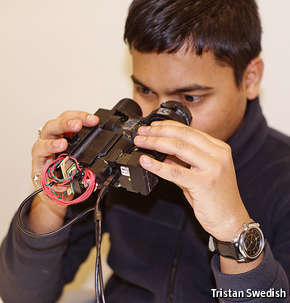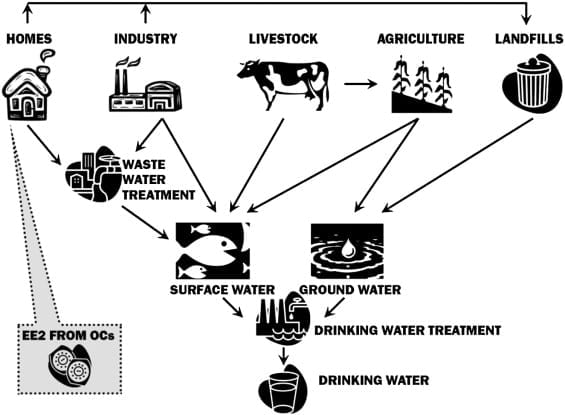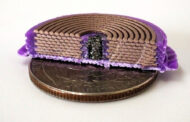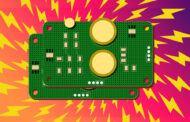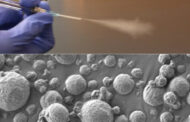A new machine can look into the eye for signs of ill health
WHETHER or not eyes are windows to the soul, they can provide a view of a person’s health. Eye problems are not the only things to show up; recent studies indicate that eyes can also reveal the presence of broader disorders like heart disease, stroke threats, diabetes, Alzheimer’s and multiple sclerosis. Frequent eye monitoring may help detect these ailments early, and now a new device promises to make that easier.
Retinal imaging is best left to professionals, not least because a doctor needs to get a patient’s eye in precisely the right position to see all the blood vessels inside. Even so, Tristan Swedish of Massachusetts Institute of Technology’s Media Lab, a place where diverse disciplines often collide in remarkable ways, speculated that it might be possible to create a device that would allow patients to take snapshots of their own retinas.
Working on the principle of “if you can see me, I can see you”, Mr Swedish describes his idea in an upcoming issue of the Association of Computing Machinery Transactions on Graphics. He generates a red light that shines through tiny holes to make it look as if there are four red lights in a diamond formation in his device. Patients initially see the lights as rather dim dots but, as they move their eyes around, they quickly notice that the dots become brighter when they look in a specific direction. When these dots become particularly bright, a second diamond of dim red lights becomes apparent inside the first four. The person then moves their eyes again until they can see all eight bright lights forming a diamond within a diamond.
Read more: Retina selfie
The Latest on: Medical self-diagnostics
[google_news title=”” keyword=”Medical self-diagnostics” num_posts=”10″ blurb_length=”0″ show_thumb=”left”]
via Google News
The Latest on: Medical self-diagnostics
- Repeat: Treatment.com AI Announces New Additions to its Medical Education Suite (MES)on April 17, 2024 at 5:22 am
Dr. Essam Hamza, CEO of Treatment.com AI, comments: “I am delighted to announce this extension to our portfolio of solutions, especially given its focus on the next generation of clinicians. Our goal ...
- New inflammatory bowel disease testing protocol could speed up diagnosison April 16, 2024 at 10:25 am
Patients with suspected inflammatory bowel disease (IBD) could benefit from better testing protocols that would reduce the need and lengthy wait for potentially unnecessary colonoscopies, a new study ...
- Therapists say more people are using social media to self- diagnose themselves with autism, other disorderson April 15, 2024 at 11:31 am
Another social media trend is alarming to doctors. This one is not about crazy stunts or eating things you shouldn't. This time, it's people diagnosing themselves with everything from depression to ...
- Medical aid in dying: Prolonging the inevitable is no way to liveon April 15, 2024 at 12:00 am
Since his ALS diagnosis in 2021, the steadily progressing disease had already stolen mobility from this man who had been physically fit and active for most of his seven decades.
- How Men's Neglect of Self-Care Impacts Their Partnerson April 12, 2024 at 4:01 pm
As Michael's health inevitably declines, culminating in a diabetes diagnosis that he tries to ... hygiene and appropriate clothing, due to medical conditions or other disability. While such forms of ...
- Study shows daily glucose levels fluctuate more than we thought, challenging diabetes diagnosison April 10, 2024 at 11:53 pm
Study reveals significant fasting glucose variability in nondiabetic adults using continuous glucose monitoring, challenging current diabetes diagnosis criteria and emphasizing the need for multiple ...
- Precision Diagnostics Can Save Money In Healthcare: What’s Holding Them Back?on April 8, 2024 at 3:02 pm
Precision medicine allows for more efficient use of costly medicines. But to accomplish this, the pricing and reimbursement model for diagnostic tests needs reform.
- Kids using social media to self-diagnose mental health conditions, survey sayson April 8, 2024 at 9:25 am
A new survey is pointing out a new social media trend — kids using the platforms to self-diagnose mental health conditions.
- Non-Lab Diagnostics: FDA Regulatory Considerationson April 4, 2024 at 5:00 pm
Medical Device Reporting (MDR ... exclusively with tests that can be performed end-to-end by the consumer. We note that some diagnostic tests that use self-collected specimens are marketed as ...
via Bing News

